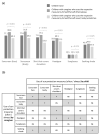Sun Protection and Tanning Behaviors in Caregivers: Prevalence, Determinants, and Associations with Children's Behaviors
- PMID: 35682459
- PMCID: PMC9180203
- DOI: 10.3390/ijerph19116876
Sun Protection and Tanning Behaviors in Caregivers: Prevalence, Determinants, and Associations with Children's Behaviors
Abstract
The association between skin cancer and ultraviolet radiation (UVR) is well established, and sun protection behavior represents an important preventative measure. In children, caregivers play a key role in this regard. The subject of this study was threefold: whether caregivers of 1 to 11 year-old children are more likely to use sun protection measures compared to non-caregivers, whether considering oneself a role model is associated with sun protection behaviors, and whether their sun protection and risk behaviors are related to children’s behaviors. We used data from the 2020 wave of the National Cancer Aid Monitoring (NCAM) comprised of 4000 individuals (including 554 caregivers of at least one child aged 1−10 years) aged 16 to 65 years and living in Germany. Data were collected through telephone interviews between October and December 2020. No significant differences between caregivers and non-caregivers regarding sun protection and risk behaviors were identified (except tanning on vacation). In both groups, sun protection behaviors were deficient. Caregivers who considered themselves role models concerning sun safety were more likely to use sun protection measures (e.g., using sunscreen on the face: OR = 5.08, p < 0.001). In addition, caregivers’ sun protection behaviors were positively associated with children’s behaviors. Caregivers being highly protected against UVR were more likely to report the use of different measures by/in the child (mean = 4.03), compared to caregivers with medium (3.41) and low (2.97, p < 0.001) protection levels. However, we also found that caregivers’ risk behavior was associated with children’s reported risk behavior. For future prevention, it might be worth focusing on the aspect of caregivers serving as role models. A comprehensive public-health strategy is needed, including key figures such as pediatricians to prevent today’s children from developing skin cancer in later life.
Keywords: Germany; caregivers; children; sun protection; sun safety; sunburn; tanning.
Conflict of interest statement
The authors declare no conflict of interest.
Figures


References
-
- Fitzmaurice C., Abate D., Abbasi N., Abbastabar H., Abd-Allah F., Abdel-Rahman O., Abdelalim A., Abdoli A., Abdollahpour I., Abdulle A.S.M., et al. Global, regional, and national cancer incidence, mortality, years of life lost, years lived with disability, and disability-adjusted life-years for 29 cancer groups, 1990 to 2017: A systematic analysis for the global burden of disease study. JAMA Oncol. 2019;5:1749–1768. doi: 10.1001/jamaoncol.2019.2996. - DOI - PMC - PubMed
Publication types
MeSH terms
Substances
LinkOut - more resources
Full Text Sources
Medical
Research Materials
Miscellaneous

